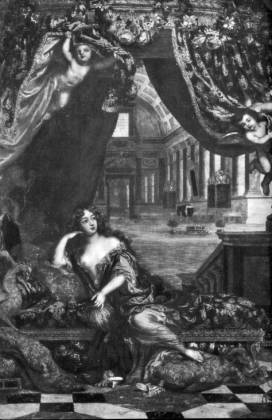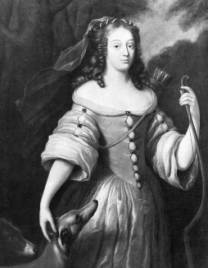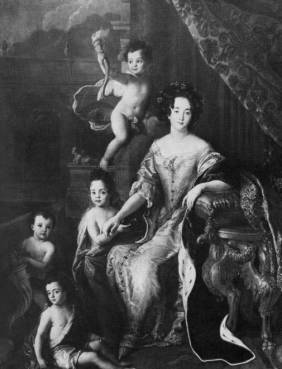April 12, 2009
Dramaturgy Part 3: Sexual Protocol in Racine's World
(This is part 3 of a package of dramaturgical material for Phèdre, written, collected and edited by Megan Cohen and Michael Paller of the American Conservatory Theater.)
Adapted in part from A History of Sexual Customs by Richard Lewinsohn and Louis XIV: a Royal Life by Olivier Bernier.
The playwright's take on infidelity in Phèdre rebuked the decadence of Louis XIV's court, and signaled the playwright's movement towards reconciliation with the Jansenist values of his upbringing.
Although earlier in his career Racine had several liaisons with actresses, as he aged he put such dalliances aside and set his passionate personality on a more pious path. Courtier Madame de Sévigné remarked that, after his return to the religious fold, "Racine loved God as he loved his mistresses."

Marquise de Montespan, mistress to Louis XIV
The sexual mores of Racine's sphere were rife with contradiction at the time of Phèdre's premiere in 1677. On the one hand, infidelity in the upper registers of society was so commonplace as to be nearly unremarkable, and the political and social power of mistresses was all but unchecked.
Voltaire said of Louis XIV, "Louis liked the ladies, and it was reciprocal." The king gave himself a constant entourage of beautiful women who traveled with him in his carriage, played cards with him, danced with him, and sometimes shared his bed. On the other hand, the rules governing the exact hierarchy of mistresses were stringent, and the considerations of dynasty and inheritance together with the pressures of religion further tightened the reins.
According to historian Richard Lewinsohn, the women with whom a prince or high-ranking noble had sexual relations fell into three strictly defined categories: consorts, lovers, and partners in pleasure. The consort had to come from a ruling House, or a House that had once enjoyed that status. Only children of such a union were entitled to succession. The second place in the sex-hierarchy was occupied by the maitresse-en-titre, or favorite, who was the official extramarital lover.
The standing of the maitresse-en-titre in social life was a very high one; in political life it was often unrivalled. The children of such unions were given high titles of nobility, and the lover's remoter kinsfolk were given comfortable appointments and imposing labels. European Courts in this age swarmed with marquesses, counts, princes and dukes who owed their high-sounding names and their estates to the sexual needs of the ruling monarch.
At the same time, even the most powerful mistresses were entirely dependent on the whims of the ruler. They enjoyed no legal security, and might fall out of favor from one day to the next and be cast out of the Court circle. (Indeed, it was one such mistress, de Montespan, who pushed for Racine's commission as official historiographer to the monarch. A handful of years later, Racine would turn on the woman, writing the play Esther, a vehicle which featured Louis' rising favorite - and eventual second wife - de Maintenon in a starring role and included de Montespan in the cast largely for the purpose of publicly humiliating her.) The relationship with a favorite usually lasted several years and took on the form of normal married life, until the mistress was discarded, often to finish out her days in a convent.

Louise de la Valliere, mistress to Louis XIV, portrayed as the goddess Diana
Very far behind the official wives and great mistresses came a third category of women, the recipients of a prince's occasional attentions: enjoyed for a night, or at most for a few weeks, their function was simply that of any courtesan. They were admitted by discreet back doors into the royal bedchamber, or into some special pavilion where the prince amused himself unbeknown to his wife or - what was more important still - to his maitresse-en-titre. As time went on, this third category came to be drawn increasingly from ladies of the stage-- actresses, singers, and dancers.
Often, Louis and his throng of companions took part in decadent ballets d'entrées, elaborate allegorical entertainments composed of spoken libretti and movement based on ballroom dances. The king first earned his nickname as the "Sun King" for dancing the role of Apollo in a ballet called The Ballet of the Night. The ballets were an opportunity for Louis' courtiers to lavish praise on the king and his pretty flock, and surviving letters and reviews remark on the performers' "incredible agility and grace," "unbelievable beauty," "touching grace," and every other imaginable combination of flattering epithets.
According to biographer Oliver Bernier, these elaborate formal spectacles contained more than a hint of less-than-speakable urges below their gilded surface, in part due to the fact that some of the participants were not always of flawless repute. Because roles were awarded based not on social status but on technical proficiency, low-ranking nobles and members of subordinate classes danced alongside the royals and their friends. Professional female dancers appeared alongside noblemen, and sometimes opposite the king himself. However, the formal nature of ballet could not whitewash all moral distinctions: it was still considered unsuitable for well-bred ladies to appear with professional male dancers, so the women danced only with men of their own caste.
As an answer to why the king suddenly stopped dancing in these sensuality-tinged demonstrations in 1669, while only 31 years old and still quite physically capable of impressive displays, one may look to Jean Racine. Racine's Brittanicus contains lines that show the Romans' disdain for the fact that their emperor plays roles in the theatre, and several biographers have pointed to this veiled commentary on Louis as the reason for the king's sudden distaste for pirouettes.

The Marquise de Montespan, pictured here with four of the children she had by Louis XIV.
In the midst of such excesses, the serious Racine called Venus "the goddess of love and death." The writer's progressively more strict Jansenist beliefs (see Dramaturgy Part 2) stood in sharp contrast to courtly doings. Scholar John Cairncross confirms that "the Jansenists disliked Louis' policies, and even more his love of pleasure, women, and fetes, including theatrical performances; and their dislike was heartily reciprocated."
Part of Racine's courtly role seemed to be as a voice of gentle dissent from the melee, and in her History of European Drama, Erika Fischer-Lichte describes the playwright's work as "in striking opposition to the views and persuasions on which court life was founded." Louis encouraged this, especially as he himself became more pious with age. After one flattering speech, the monarch told Racine: "I would praise it more if you had praised me less."
(For more on the sexual protocols of this world, see the excerpt from the Duc de Saint-Simon's Memoirs in Dramaturgy Part 5.)